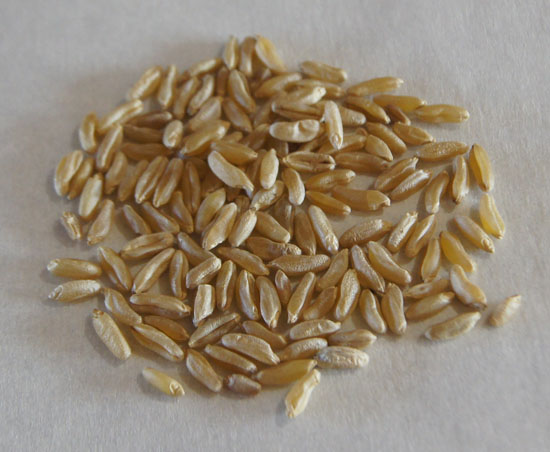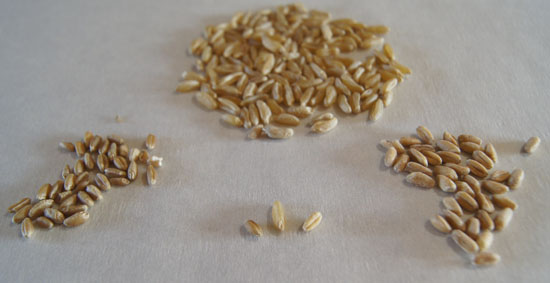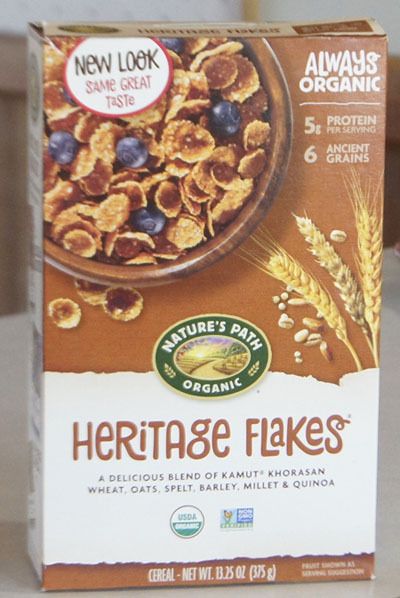I bought a bag of Bob’s Red Mill “Kamut” at Safeway yesterday. The cashier, an interesting woman from Eastern Europe who has worked at that store for years, held the bag in her hands and peered at the label. “What is this? What are you going to do with it?” I said, “I have no idea, really. I am studying unusual grains because I am curious about them!”
“The history of this ancient wheat grain is a bit mysterious” reads the package. Ooh, a mystery! It’s known as “Prophet’s Wheat” because some believe that Noah brought kamut along on the ark. It is also known as “King Tut’s Wheat”, because some say that it was found in the tomb of that Egyptian pharaoh. On the Bob’s Red Mill package, it is also called the “traditional grain of Egypt”.
Wikipedia tells me that kamut is also known as “Khorasan wheat” or “Oriental wheat”. It is a tetraploid wheat species, scientifically Triticum turanicum. It is one of the ancient grains. Khorasan is a kingdom that existed in what is now parts of Iran, Iraq, Central Asia, Afghanistan, and Egypt.
The story of how Kamut came to the United States begins in 1949, according to the Kamut® Brand Khorasan wheat website. A US airman stationed in Portugal came upon an unusual grain in the markets. He sent “thirty-six kernels of the wheat” to his father, a farmer in the US. His father grew those seeds into many bushels, and passed those seeds out at a county fair. A teen, Bob Quinn, was at the fair and saw the seeds. He went on to get a PhD in Plant Biochemistry, and when he returned to the family farm years later, he and his father found and grew some of those large grains, now known as kamut. In 1990, “the ‘KAMUT®’ trademark was registered to be used as a guarantee that the original grain would remain unmodified and always grown organically”.
Whole berries of kamut are larger than the common wheat berries that I covered in another post. They have a “chewy, toothsome texture and nutty, rich flavor makes a delicious spring and summer salad” according to Food Republic. That same site also reports that kamut has more protein than most wheat, and some people who are allergic to wheat can tolerate kamut. King Arthur Flour says kamut flour has a “rich and buttery” flavor, and in quick and yeast breads, lends a light and tender effect to baked products.
Uncooked kamut berries:

Below is kamut compared to common wheat berries and farro. This is the order: wheat – kamut – farro. The kamut is notably larger.

Kamut compared to medium grain brown rice:

Kamut flour and flakes are currently added to a wide variety of food products. I searched the cereal section of Whole Foods and found a cereal that contains kamut, as well as oats, spelt, barley, millet, and quinoa. This cereal has a delicious crunch!
 Nutrition
Nutrition
1/4 cup of dry kamut has 160 calories, 4 grams fiber, 7 grams protein, some calcium and vitamin B6, 15% of recommended daily magnesium, and 10% each of iron and zinc.
The glycemic index (GI) of kamut is reported on several sites as between 40 and 45. (Anything under 55 is pretty good for a grain.) Whole berry and coarsely ground kamut have lower GI values than flakes and flour kamut products. (Sources: Kamut®, Four Winds Nutrition, and Traditionally Me websites.) The variety of GI values is probably because GI varies, in general, depending on the processing of the grain.
An article in the European Journal of Clinical Nutrition discusses the beneficial effect of kamut on cardiovascular risk factors. A quote: “consumption of Kamut products showed a significant reduction of metabolic risk factors such as total cholesterol, low-density lipoprotein cholesterol and blood glucose compared to control semi-whole-grain wheat. (Source: Characterization of Khorasan wheat (Kamut) and impact of a replacement diet on cardiovascular risk factors: cross-over dietary intervention study, by F. Sofi et al, European Journal of Clinical Nutrition volume 67, pages 190–195, 2013.)
The kamut I bought is a whole grain, as specified by this definition from wikipedia: “A whole grain is a grain of any cereal and pseudocereal that contains the endosperm, germ, and bran, in contrast to refined grains, which retain only the endosperm”.
Cooking
The Bob’s Red Mill package says to soak one cup of kamut in water overnight, then boil in 3 cups of water for 30-40 minutes. Or, skip the pre-soak and boil for 45-60 minutes. To me, that screams “try a pressure cooker!” Why? Because in Colorado at 5400 feet, things take longer to cook anyway, and it’s summer and I don’t want to be boiling anything on the stove for a long period of time. And also, I have an electric pressure cooker. So I google, and find how to cook kamut in a pressure cooker on the Food Storage Moms website.
| water | cooking time | |
| 1 cup kamut | 3 cups | 40-60 minutes |
| 1 cup kamut, presoaked in water overnight | 3 cups | 30-40 minutes |
| 1 cup kamut | 2 cups | 30 minutes in pressure cooker, high, fast release |
Below is my photo of pressure-cooked kamut. I found it delicious! Big kernels of nutty, chewy, and even “buttery” tastiness. But hubby called them “rubbery”. Nevertheless, my son and his wife really enjoyed the tabouleh-style salad I made from them.

Recipes
Much as I serve wheat berries, cracked wheat, and bulgur, I like kamut in tabouleh-style salads with fresh herbs like mint and cilantro, sharp cheeses like feta, nuts, any chopped vegetables, and a light dressing of olive oil and vinegar or lemon. Cooked kamut might be good added to My Daily Bread. Kamut would be good in breakfast cereals, but I would mix it with other grains.
King Arthur Flour sells kamut flour and recommends substituting some of the all purpose flour in recipes with kamut flour, with these general guidelines. As examples, they offer recipes for banana bread, scones, muffins, pancakes, and cinnamon bread (a yeast bread).
Oldways Whole Grain Council suggests this recipe:
The Kamut Brand Khorasan site has a wide variety of recipes including:
-
Khorasan Wheat, Sweet Potato, Kale, and Avocado Bowl
-
Khorasan Wheat Bread – Bread Machine
-
Wheat Tortillas
-
Khorasan Wheat Sicilian-Style Pizza
-
Khorasan Wheat Pilaf
-
Khorasan Wheat Cashew and Apricot Pilaf
- Kamut, Quinoa, and Black Barley
Food network’s Healthy Eats:
- a list of 24 items you can add to kamut and other grains along with oil and vinegar of course
Glue and Glitter offers a recipe for Kamut Pilaf with pumpkin seeds, onions, and carrots. That site also links to more kamut recipes.
Below is the package of kamut I bought. On the back is a recipe for “Kushari”, with kamut, lentils, elbow macaroni, onions, oil, garlic, cumin, red pepper flakes, and tomato sauce.

